Critical Analysis of Nurse-Patient Ratio in Queensland Hospital Report
VerifiedAdded on 2020/07/22
|7
|2165
|66
Report
AI Summary
This report provides a critical analysis of the nurse-patient ratio within Queensland Hospital, focusing on its impact on patient outcomes. The study defines the core issue of maintaining an adequate nurse-to-patient ratio, which is crucial for effective medical treatment and patient trust. It compares and contrasts qualitative and quantitative approaches, detailing their application in addressing nurses' and patients' issues. The qualitative approach is used to gain in-depth understanding, while the quantitative approach is used to analyze data. The report also examines various patient issues stemming from inadequate staffing, such as medication errors and rude behavior, and proposes strategies for improvement. The reflection section offers a personal perspective on these issues. The conclusion summarizes the importance of maintaining a balanced nurse-patient ratio for enhancing hospital performance. The report uses several journal articles and books to support its findings.
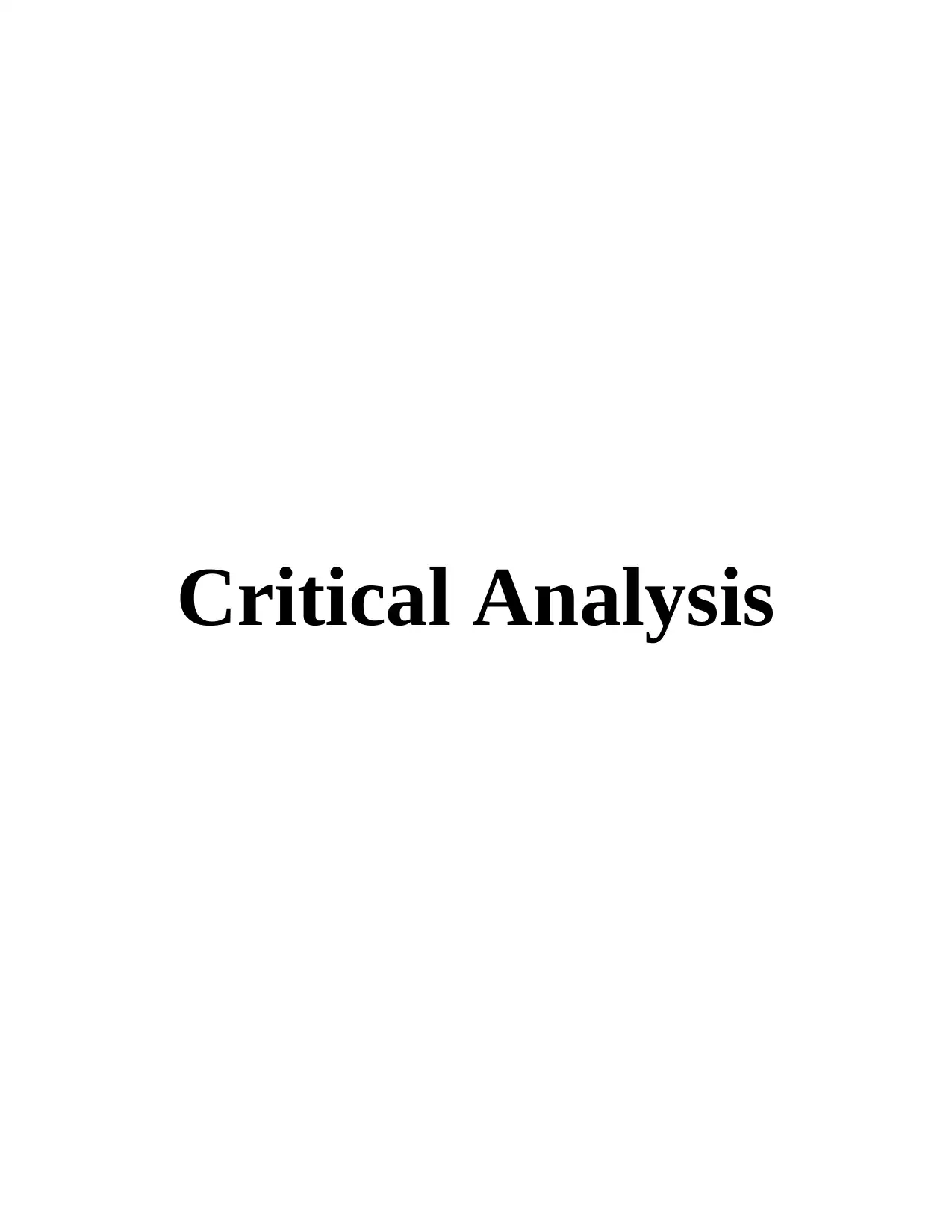
Critical Analysis
Paraphrase This Document
Need a fresh take? Get an instant paraphrase of this document with our AI Paraphraser
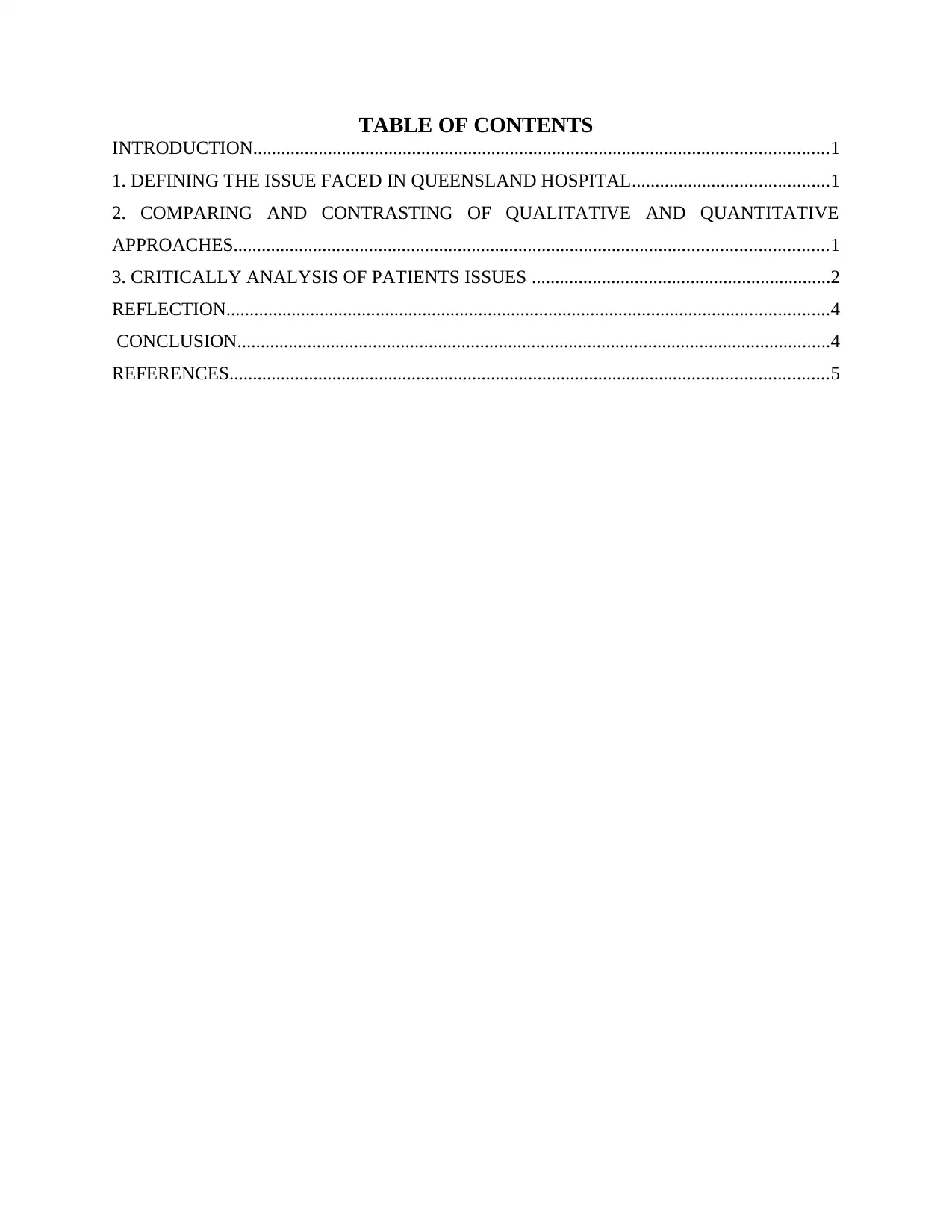
TABLE OF CONTENTS
INTRODUCTION...........................................................................................................................1
1. DEFINING THE ISSUE FACED IN QUEENSLAND HOSPITAL..........................................1
2. COMPARING AND CONTRASTING OF QUALITATIVE AND QUANTITATIVE
APPROACHES...............................................................................................................................1
3. CRITICALLY ANALYSIS OF PATIENTS ISSUES ................................................................2
REFLECTION.................................................................................................................................4
CONCLUSION...............................................................................................................................4
REFERENCES................................................................................................................................5
INTRODUCTION...........................................................................................................................1
1. DEFINING THE ISSUE FACED IN QUEENSLAND HOSPITAL..........................................1
2. COMPARING AND CONTRASTING OF QUALITATIVE AND QUANTITATIVE
APPROACHES...............................................................................................................................1
3. CRITICALLY ANALYSIS OF PATIENTS ISSUES ................................................................2
REFLECTION.................................................................................................................................4
CONCLUSION...............................................................................................................................4
REFERENCES................................................................................................................................5
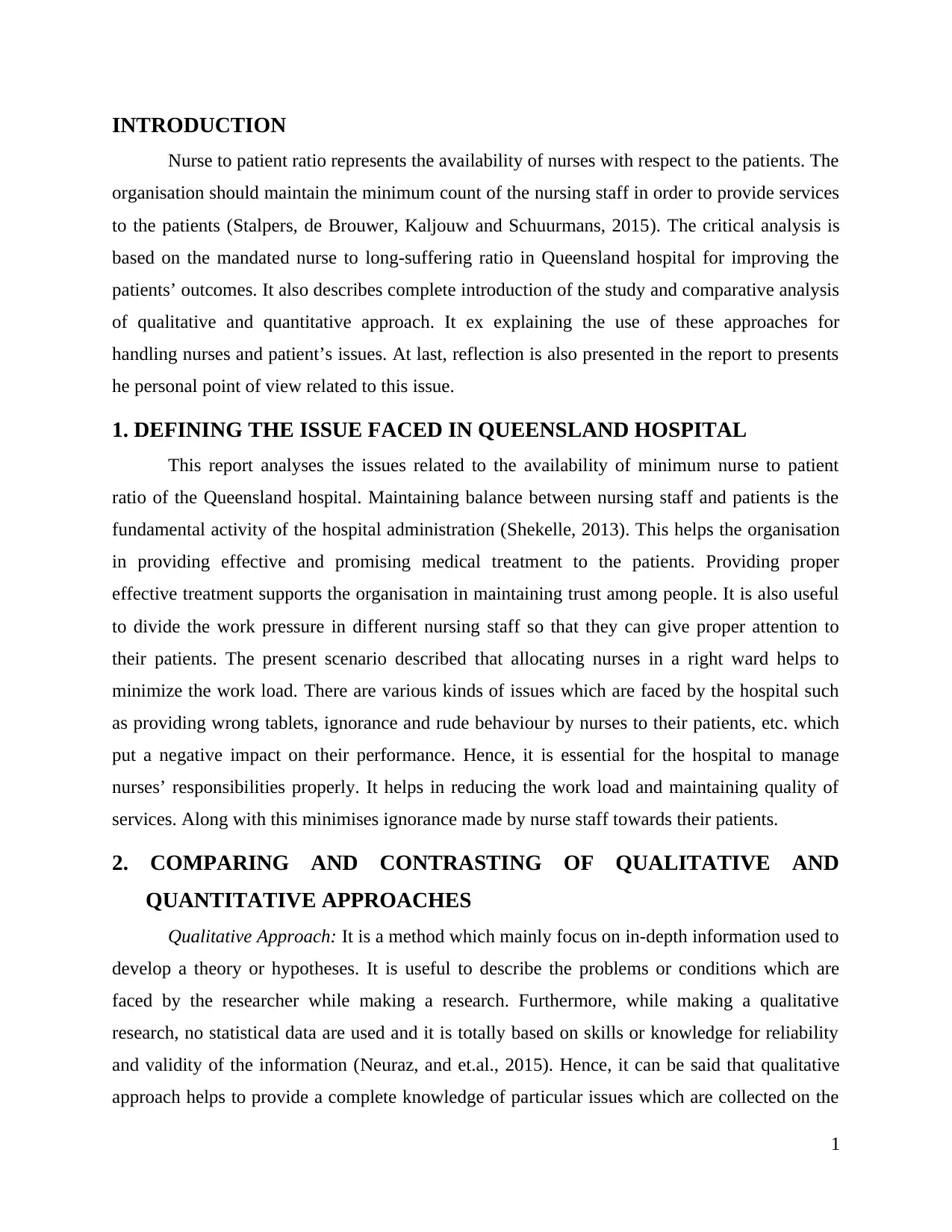
INTRODUCTION
Nurse to patient ratio represents the availability of nurses with respect to the patients. The
organisation should maintain the minimum count of the nursing staff in order to provide services
to the patients (Stalpers, de Brouwer, Kaljouw and Schuurmans, 2015). The critical analysis is
based on the mandated nurse to long-suffering ratio in Queensland hospital for improving the
patients’ outcomes. It also describes complete introduction of the study and comparative analysis
of qualitative and quantitative approach. It ex explaining the use of these approaches for
handling nurses and patient’s issues. At last, reflection is also presented in the report to presents
he personal point of view related to this issue.
1. DEFINING THE ISSUE FACED IN QUEENSLAND HOSPITAL
This report analyses the issues related to the availability of minimum nurse to patient
ratio of the Queensland hospital. Maintaining balance between nursing staff and patients is the
fundamental activity of the hospital administration (Shekelle, 2013). This helps the organisation
in providing effective and promising medical treatment to the patients. Providing proper
effective treatment supports the organisation in maintaining trust among people. It is also useful
to divide the work pressure in different nursing staff so that they can give proper attention to
their patients. The present scenario described that allocating nurses in a right ward helps to
minimize the work load. There are various kinds of issues which are faced by the hospital such
as providing wrong tablets, ignorance and rude behaviour by nurses to their patients, etc. which
put a negative impact on their performance. Hence, it is essential for the hospital to manage
nurses’ responsibilities properly. It helps in reducing the work load and maintaining quality of
services. Along with this minimises ignorance made by nurse staff towards their patients.
2. COMPARING AND CONTRASTING OF QUALITATIVE AND
QUANTITATIVE APPROACHES
Qualitative Approach: It is a method which mainly focus on in-depth information used to
develop a theory or hypotheses. It is useful to describe the problems or conditions which are
faced by the researcher while making a research. Furthermore, while making a qualitative
research, no statistical data are used and it is totally based on skills or knowledge for reliability
and validity of the information (Neuraz, and et.al., 2015). Hence, it can be said that qualitative
approach helps to provide a complete knowledge of particular issues which are collected on the
1
Nurse to patient ratio represents the availability of nurses with respect to the patients. The
organisation should maintain the minimum count of the nursing staff in order to provide services
to the patients (Stalpers, de Brouwer, Kaljouw and Schuurmans, 2015). The critical analysis is
based on the mandated nurse to long-suffering ratio in Queensland hospital for improving the
patients’ outcomes. It also describes complete introduction of the study and comparative analysis
of qualitative and quantitative approach. It ex explaining the use of these approaches for
handling nurses and patient’s issues. At last, reflection is also presented in the report to presents
he personal point of view related to this issue.
1. DEFINING THE ISSUE FACED IN QUEENSLAND HOSPITAL
This report analyses the issues related to the availability of minimum nurse to patient
ratio of the Queensland hospital. Maintaining balance between nursing staff and patients is the
fundamental activity of the hospital administration (Shekelle, 2013). This helps the organisation
in providing effective and promising medical treatment to the patients. Providing proper
effective treatment supports the organisation in maintaining trust among people. It is also useful
to divide the work pressure in different nursing staff so that they can give proper attention to
their patients. The present scenario described that allocating nurses in a right ward helps to
minimize the work load. There are various kinds of issues which are faced by the hospital such
as providing wrong tablets, ignorance and rude behaviour by nurses to their patients, etc. which
put a negative impact on their performance. Hence, it is essential for the hospital to manage
nurses’ responsibilities properly. It helps in reducing the work load and maintaining quality of
services. Along with this minimises ignorance made by nurse staff towards their patients.
2. COMPARING AND CONTRASTING OF QUALITATIVE AND
QUANTITATIVE APPROACHES
Qualitative Approach: It is a method which mainly focus on in-depth information used to
develop a theory or hypotheses. It is useful to describe the problems or conditions which are
faced by the researcher while making a research. Furthermore, while making a qualitative
research, no statistical data are used and it is totally based on skills or knowledge for reliability
and validity of the information (Neuraz, and et.al., 2015). Hence, it can be said that qualitative
approach helps to provide a complete knowledge of particular issues which are collected on the
1
⊘ This is a preview!⊘
Do you want full access?
Subscribe today to unlock all pages.

Trusted by 1+ million students worldwide
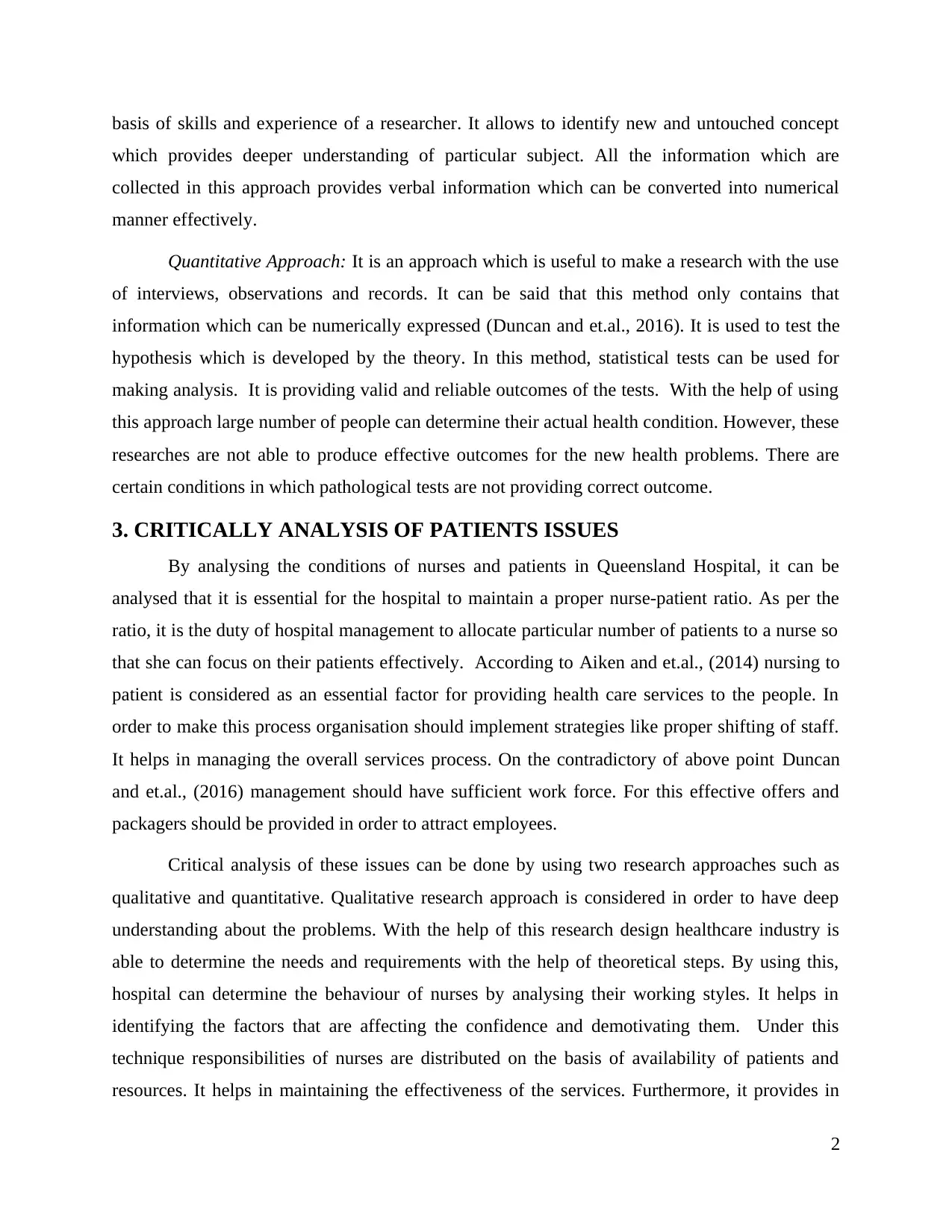
basis of skills and experience of a researcher. It allows to identify new and untouched concept
which provides deeper understanding of particular subject. All the information which are
collected in this approach provides verbal information which can be converted into numerical
manner effectively.
Quantitative Approach: It is an approach which is useful to make a research with the use
of interviews, observations and records. It can be said that this method only contains that
information which can be numerically expressed (Duncan and et.al., 2016). It is used to test the
hypothesis which is developed by the theory. In this method, statistical tests can be used for
making analysis. It is providing valid and reliable outcomes of the tests. With the help of using
this approach large number of people can determine their actual health condition. However, these
researches are not able to produce effective outcomes for the new health problems. There are
certain conditions in which pathological tests are not providing correct outcome.
3. CRITICALLY ANALYSIS OF PATIENTS ISSUES
By analysing the conditions of nurses and patients in Queensland Hospital, it can be
analysed that it is essential for the hospital to maintain a proper nurse-patient ratio. As per the
ratio, it is the duty of hospital management to allocate particular number of patients to a nurse so
that she can focus on their patients effectively. According to Aiken and et.al., (2014) nursing to
patient is considered as an essential factor for providing health care services to the people. In
order to make this process organisation should implement strategies like proper shifting of staff.
It helps in managing the overall services process. On the contradictory of above point Duncan
and et.al., (2016) management should have sufficient work force. For this effective offers and
packagers should be provided in order to attract employees.
Critical analysis of these issues can be done by using two research approaches such as
qualitative and quantitative. Qualitative research approach is considered in order to have deep
understanding about the problems. With the help of this research design healthcare industry is
able to determine the needs and requirements with the help of theoretical steps. By using this,
hospital can determine the behaviour of nurses by analysing their working styles. It helps in
identifying the factors that are affecting the confidence and demotivating them. Under this
technique responsibilities of nurses are distributed on the basis of availability of patients and
resources. It helps in maintaining the effectiveness of the services. Furthermore, it provides in
2
which provides deeper understanding of particular subject. All the information which are
collected in this approach provides verbal information which can be converted into numerical
manner effectively.
Quantitative Approach: It is an approach which is useful to make a research with the use
of interviews, observations and records. It can be said that this method only contains that
information which can be numerically expressed (Duncan and et.al., 2016). It is used to test the
hypothesis which is developed by the theory. In this method, statistical tests can be used for
making analysis. It is providing valid and reliable outcomes of the tests. With the help of using
this approach large number of people can determine their actual health condition. However, these
researches are not able to produce effective outcomes for the new health problems. There are
certain conditions in which pathological tests are not providing correct outcome.
3. CRITICALLY ANALYSIS OF PATIENTS ISSUES
By analysing the conditions of nurses and patients in Queensland Hospital, it can be
analysed that it is essential for the hospital to maintain a proper nurse-patient ratio. As per the
ratio, it is the duty of hospital management to allocate particular number of patients to a nurse so
that she can focus on their patients effectively. According to Aiken and et.al., (2014) nursing to
patient is considered as an essential factor for providing health care services to the people. In
order to make this process organisation should implement strategies like proper shifting of staff.
It helps in managing the overall services process. On the contradictory of above point Duncan
and et.al., (2016) management should have sufficient work force. For this effective offers and
packagers should be provided in order to attract employees.
Critical analysis of these issues can be done by using two research approaches such as
qualitative and quantitative. Qualitative research approach is considered in order to have deep
understanding about the problems. With the help of this research design healthcare industry is
able to determine the needs and requirements with the help of theoretical steps. By using this,
hospital can determine the behaviour of nurses by analysing their working styles. It helps in
identifying the factors that are affecting the confidence and demotivating them. Under this
technique responsibilities of nurses are distributed on the basis of availability of patients and
resources. It helps in maintaining the effectiveness of the services. Furthermore, it provides in
2
Paraphrase This Document
Need a fresh take? Get an instant paraphrase of this document with our AI Paraphraser
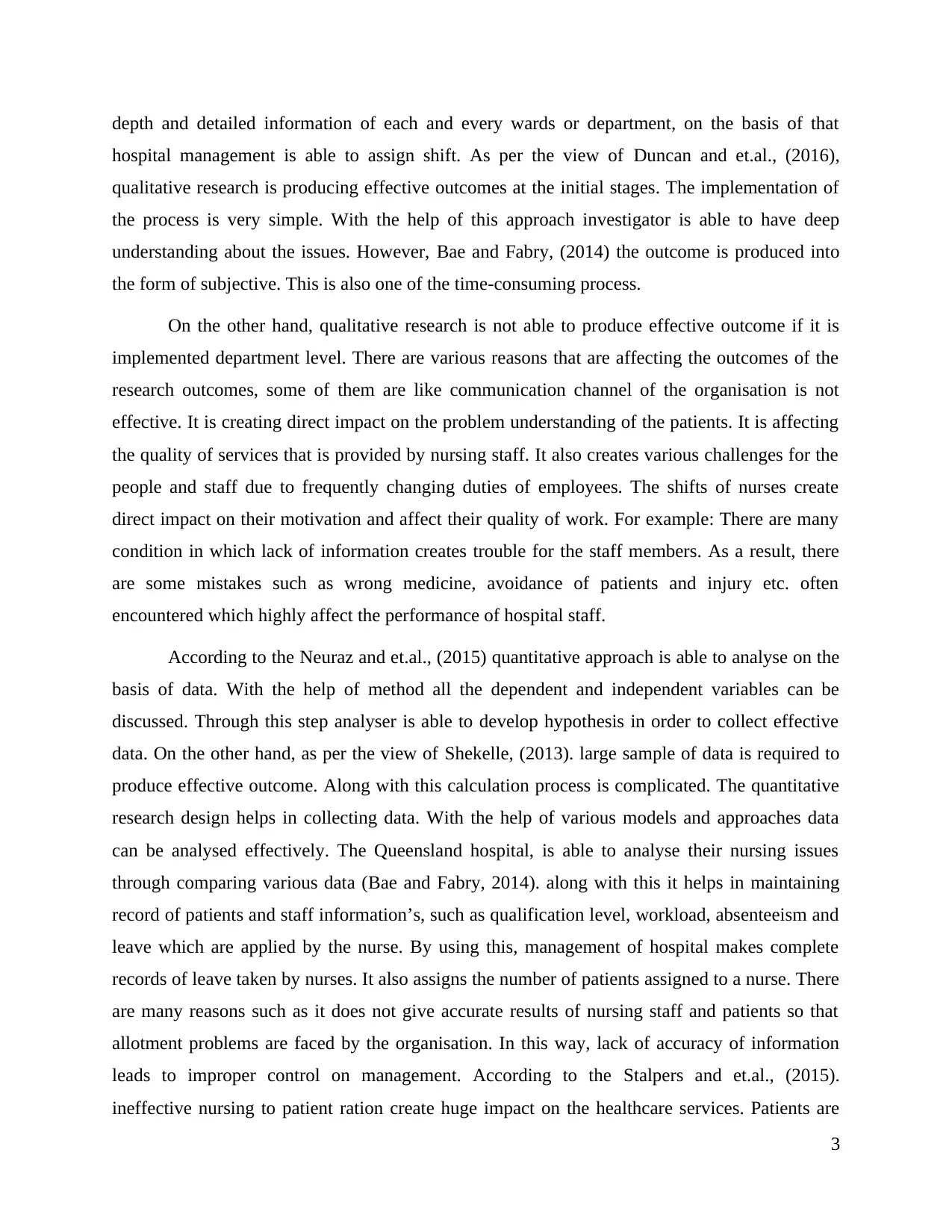
depth and detailed information of each and every wards or department, on the basis of that
hospital management is able to assign shift. As per the view of Duncan and et.al., (2016),
qualitative research is producing effective outcomes at the initial stages. The implementation of
the process is very simple. With the help of this approach investigator is able to have deep
understanding about the issues. However, Bae and Fabry, (2014) the outcome is produced into
the form of subjective. This is also one of the time-consuming process.
On the other hand, qualitative research is not able to produce effective outcome if it is
implemented department level. There are various reasons that are affecting the outcomes of the
research outcomes, some of them are like communication channel of the organisation is not
effective. It is creating direct impact on the problem understanding of the patients. It is affecting
the quality of services that is provided by nursing staff. It also creates various challenges for the
people and staff due to frequently changing duties of employees. The shifts of nurses create
direct impact on their motivation and affect their quality of work. For example: There are many
condition in which lack of information creates trouble for the staff members. As a result, there
are some mistakes such as wrong medicine, avoidance of patients and injury etc. often
encountered which highly affect the performance of hospital staff.
According to the Neuraz and et.al., (2015) quantitative approach is able to analyse on the
basis of data. With the help of method all the dependent and independent variables can be
discussed. Through this step analyser is able to develop hypothesis in order to collect effective
data. On the other hand, as per the view of Shekelle, (2013). large sample of data is required to
produce effective outcome. Along with this calculation process is complicated. The quantitative
research design helps in collecting data. With the help of various models and approaches data
can be analysed effectively. The Queensland hospital, is able to analyse their nursing issues
through comparing various data (Bae and Fabry, 2014). along with this it helps in maintaining
record of patients and staff information’s, such as qualification level, workload, absenteeism and
leave which are applied by the nurse. By using this, management of hospital makes complete
records of leave taken by nurses. It also assigns the number of patients assigned to a nurse. There
are many reasons such as it does not give accurate results of nursing staff and patients so that
allotment problems are faced by the organisation. In this way, lack of accuracy of information
leads to improper control on management. According to the Stalpers and et.al., (2015).
ineffective nursing to patient ration create huge impact on the healthcare services. Patients are
3
hospital management is able to assign shift. As per the view of Duncan and et.al., (2016),
qualitative research is producing effective outcomes at the initial stages. The implementation of
the process is very simple. With the help of this approach investigator is able to have deep
understanding about the issues. However, Bae and Fabry, (2014) the outcome is produced into
the form of subjective. This is also one of the time-consuming process.
On the other hand, qualitative research is not able to produce effective outcome if it is
implemented department level. There are various reasons that are affecting the outcomes of the
research outcomes, some of them are like communication channel of the organisation is not
effective. It is creating direct impact on the problem understanding of the patients. It is affecting
the quality of services that is provided by nursing staff. It also creates various challenges for the
people and staff due to frequently changing duties of employees. The shifts of nurses create
direct impact on their motivation and affect their quality of work. For example: There are many
condition in which lack of information creates trouble for the staff members. As a result, there
are some mistakes such as wrong medicine, avoidance of patients and injury etc. often
encountered which highly affect the performance of hospital staff.
According to the Neuraz and et.al., (2015) quantitative approach is able to analyse on the
basis of data. With the help of method all the dependent and independent variables can be
discussed. Through this step analyser is able to develop hypothesis in order to collect effective
data. On the other hand, as per the view of Shekelle, (2013). large sample of data is required to
produce effective outcome. Along with this calculation process is complicated. The quantitative
research design helps in collecting data. With the help of various models and approaches data
can be analysed effectively. The Queensland hospital, is able to analyse their nursing issues
through comparing various data (Bae and Fabry, 2014). along with this it helps in maintaining
record of patients and staff information’s, such as qualification level, workload, absenteeism and
leave which are applied by the nurse. By using this, management of hospital makes complete
records of leave taken by nurses. It also assigns the number of patients assigned to a nurse. There
are many reasons such as it does not give accurate results of nursing staff and patients so that
allotment problems are faced by the organisation. In this way, lack of accuracy of information
leads to improper control on management. According to the Stalpers and et.al., (2015).
ineffective nursing to patient ration create huge impact on the healthcare services. Patients are
3
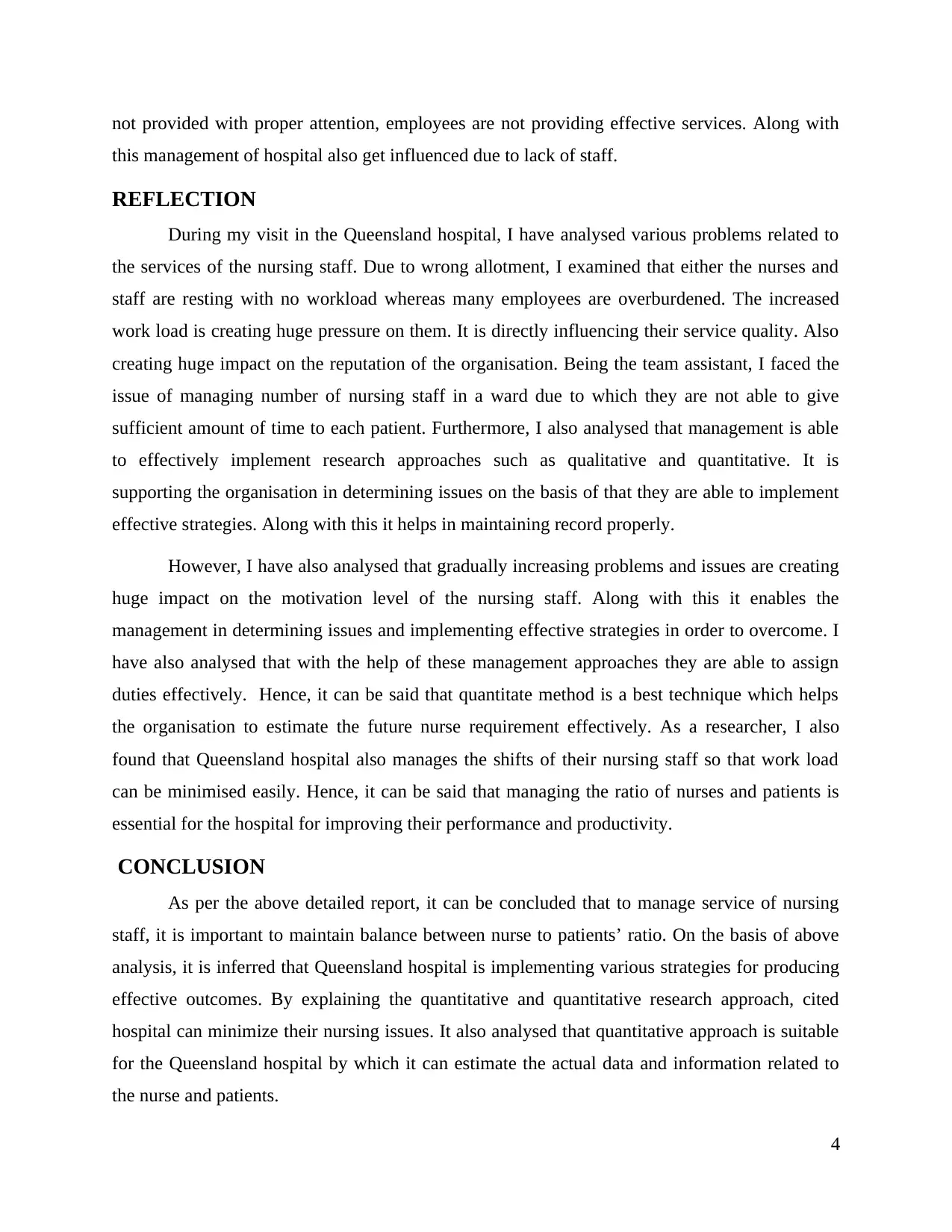
not provided with proper attention, employees are not providing effective services. Along with
this management of hospital also get influenced due to lack of staff.
REFLECTION
During my visit in the Queensland hospital, I have analysed various problems related to
the services of the nursing staff. Due to wrong allotment, I examined that either the nurses and
staff are resting with no workload whereas many employees are overburdened. The increased
work load is creating huge pressure on them. It is directly influencing their service quality. Also
creating huge impact on the reputation of the organisation. Being the team assistant, I faced the
issue of managing number of nursing staff in a ward due to which they are not able to give
sufficient amount of time to each patient. Furthermore, I also analysed that management is able
to effectively implement research approaches such as qualitative and quantitative. It is
supporting the organisation in determining issues on the basis of that they are able to implement
effective strategies. Along with this it helps in maintaining record properly.
However, I have also analysed that gradually increasing problems and issues are creating
huge impact on the motivation level of the nursing staff. Along with this it enables the
management in determining issues and implementing effective strategies in order to overcome. I
have also analysed that with the help of these management approaches they are able to assign
duties effectively. Hence, it can be said that quantitate method is a best technique which helps
the organisation to estimate the future nurse requirement effectively. As a researcher, I also
found that Queensland hospital also manages the shifts of their nursing staff so that work load
can be minimised easily. Hence, it can be said that managing the ratio of nurses and patients is
essential for the hospital for improving their performance and productivity.
CONCLUSION
As per the above detailed report, it can be concluded that to manage service of nursing
staff, it is important to maintain balance between nurse to patients’ ratio. On the basis of above
analysis, it is inferred that Queensland hospital is implementing various strategies for producing
effective outcomes. By explaining the quantitative and quantitative research approach, cited
hospital can minimize their nursing issues. It also analysed that quantitative approach is suitable
for the Queensland hospital by which it can estimate the actual data and information related to
the nurse and patients.
4
this management of hospital also get influenced due to lack of staff.
REFLECTION
During my visit in the Queensland hospital, I have analysed various problems related to
the services of the nursing staff. Due to wrong allotment, I examined that either the nurses and
staff are resting with no workload whereas many employees are overburdened. The increased
work load is creating huge pressure on them. It is directly influencing their service quality. Also
creating huge impact on the reputation of the organisation. Being the team assistant, I faced the
issue of managing number of nursing staff in a ward due to which they are not able to give
sufficient amount of time to each patient. Furthermore, I also analysed that management is able
to effectively implement research approaches such as qualitative and quantitative. It is
supporting the organisation in determining issues on the basis of that they are able to implement
effective strategies. Along with this it helps in maintaining record properly.
However, I have also analysed that gradually increasing problems and issues are creating
huge impact on the motivation level of the nursing staff. Along with this it enables the
management in determining issues and implementing effective strategies in order to overcome. I
have also analysed that with the help of these management approaches they are able to assign
duties effectively. Hence, it can be said that quantitate method is a best technique which helps
the organisation to estimate the future nurse requirement effectively. As a researcher, I also
found that Queensland hospital also manages the shifts of their nursing staff so that work load
can be minimised easily. Hence, it can be said that managing the ratio of nurses and patients is
essential for the hospital for improving their performance and productivity.
CONCLUSION
As per the above detailed report, it can be concluded that to manage service of nursing
staff, it is important to maintain balance between nurse to patients’ ratio. On the basis of above
analysis, it is inferred that Queensland hospital is implementing various strategies for producing
effective outcomes. By explaining the quantitative and quantitative research approach, cited
hospital can minimize their nursing issues. It also analysed that quantitative approach is suitable
for the Queensland hospital by which it can estimate the actual data and information related to
the nurse and patients.
4
⊘ This is a preview!⊘
Do you want full access?
Subscribe today to unlock all pages.

Trusted by 1+ million students worldwide
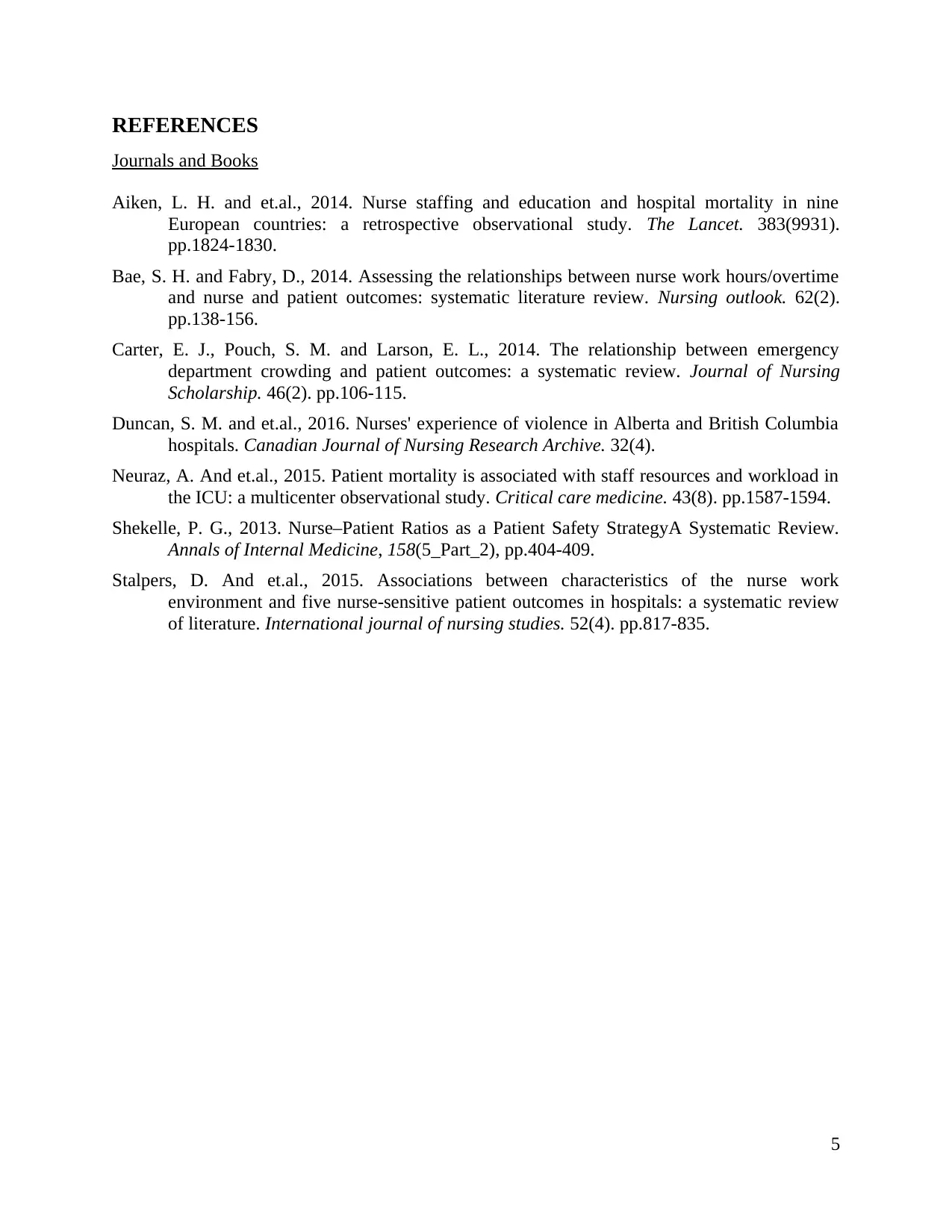
REFERENCES
Journals and Books
Aiken, L. H. and et.al., 2014. Nurse staffing and education and hospital mortality in nine
European countries: a retrospective observational study. The Lancet. 383(9931).
pp.1824-1830.
Bae, S. H. and Fabry, D., 2014. Assessing the relationships between nurse work hours/overtime
and nurse and patient outcomes: systematic literature review. Nursing outlook. 62(2).
pp.138-156.
Carter, E. J., Pouch, S. M. and Larson, E. L., 2014. The relationship between emergency
department crowding and patient outcomes: a systematic review. Journal of Nursing
Scholarship. 46(2). pp.106-115.
Duncan, S. M. and et.al., 2016. Nurses' experience of violence in Alberta and British Columbia
hospitals. Canadian Journal of Nursing Research Archive. 32(4).
Neuraz, A. And et.al., 2015. Patient mortality is associated with staff resources and workload in
the ICU: a multicenter observational study. Critical care medicine. 43(8). pp.1587-1594.
Shekelle, P. G., 2013. Nurse–Patient Ratios as a Patient Safety StrategyA Systematic Review.
Annals of Internal Medicine, 158(5_Part_2), pp.404-409.
Stalpers, D. And et.al., 2015. Associations between characteristics of the nurse work
environment and five nurse-sensitive patient outcomes in hospitals: a systematic review
of literature. International journal of nursing studies. 52(4). pp.817-835.
5
Journals and Books
Aiken, L. H. and et.al., 2014. Nurse staffing and education and hospital mortality in nine
European countries: a retrospective observational study. The Lancet. 383(9931).
pp.1824-1830.
Bae, S. H. and Fabry, D., 2014. Assessing the relationships between nurse work hours/overtime
and nurse and patient outcomes: systematic literature review. Nursing outlook. 62(2).
pp.138-156.
Carter, E. J., Pouch, S. M. and Larson, E. L., 2014. The relationship between emergency
department crowding and patient outcomes: a systematic review. Journal of Nursing
Scholarship. 46(2). pp.106-115.
Duncan, S. M. and et.al., 2016. Nurses' experience of violence in Alberta and British Columbia
hospitals. Canadian Journal of Nursing Research Archive. 32(4).
Neuraz, A. And et.al., 2015. Patient mortality is associated with staff resources and workload in
the ICU: a multicenter observational study. Critical care medicine. 43(8). pp.1587-1594.
Shekelle, P. G., 2013. Nurse–Patient Ratios as a Patient Safety StrategyA Systematic Review.
Annals of Internal Medicine, 158(5_Part_2), pp.404-409.
Stalpers, D. And et.al., 2015. Associations between characteristics of the nurse work
environment and five nurse-sensitive patient outcomes in hospitals: a systematic review
of literature. International journal of nursing studies. 52(4). pp.817-835.
5
1 out of 7
Related Documents
Your All-in-One AI-Powered Toolkit for Academic Success.
+13062052269
info@desklib.com
Available 24*7 on WhatsApp / Email
![[object Object]](/_next/static/media/star-bottom.7253800d.svg)
Unlock your academic potential
Copyright © 2020–2025 A2Z Services. All Rights Reserved. Developed and managed by ZUCOL.





